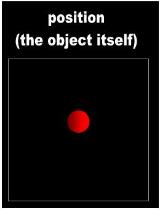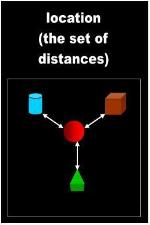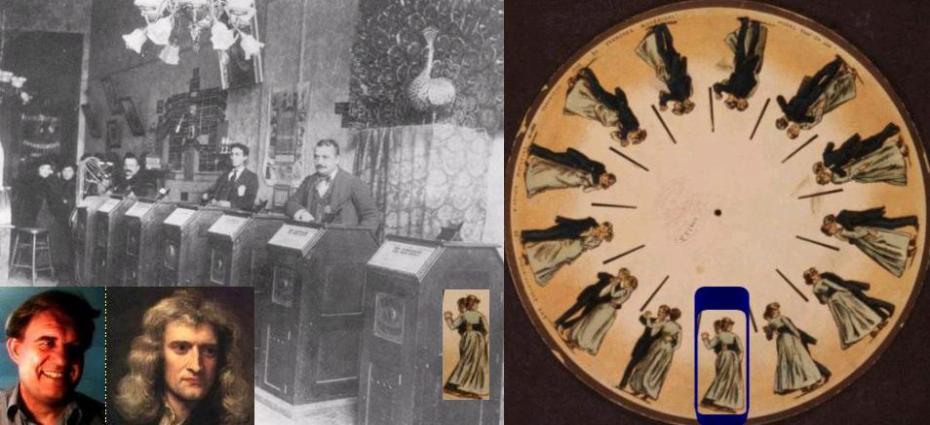1.0 'What is your position, R2D2?'
The mathematicians have developed the most incongruous language to define some of the simplest words in our vocabulary.
One of the most ridiculous definitions of Math is the word position. In the contorted language of Mathematical Physics, position
is not the volume of space occupied by your body, but rather a coordinate system to locate you on Earth:
- " position: A location in a coordinate system, usually in two or more dimensions" [1]
...where a coordinate system is:
- " a system for assigning an n-tuple of numbers or scalars to each point in an
n-dimensional space." [2]
When you ask a relativist, 'What is your position on this matter?' he answers robotically: '49 degrees longitude, 25 degrees
latitude.'
Of course, it should not surprise you that in their crazy mathematical world of quantities, the scholars never found a reason
to distinguish position from location:
" location: In geography, location is a position... A real location can often be designated
using a specific pairing of latitude and longitude, a Cartesian coordinate grid" [3]
This is how the establishment ended up defining motion in terms of location and concluding that it consists of a dynamic
coordinate system:
- " motion means a continuous change in the location of a body... Motion involves change
in position" [4]
The only part of this definition that the mathematicians got right is that motion requires a body. The rest of the notions are
not only wrong, but quite amusing: continuous is an adjective, change is a synonym of motion, and positions and locations
don't normally move to other locations.
2.0 The scientific definitions of location, position, and motion
In a universe consisting of a single shape, the object merely has position. From a conceptual point of view, position is the
volume of space displaced or occupied by an object. However, if space is a place (as opposed to an object), no such
displacement or occupation occurs. You do not 'occupy' or 'inhabit' space the way a fish 'occupies' or 'inhabits' the ocean:
by displacing atoms and molecules. When an object 'occupies' space, it does not displace anything. The object merely has
a location with respect to the remaining objects in the Universe. In this context, there is no meaning or purpose for the word
position in Physics. We don't need this word in Science. Position is the object itself.
For location to acquire meaning, two or more objects must inhabit the frame of the film (Fig. 1):
- position: A hypothetical or imaginary volume of space occupied by a real object;
the object itself.
location: The set of distances from the test object to the remaining objects. (Not to
be confused with position.)
Motion requires more than one location of one object. Whereas distance, position, and location are attributes of a static
Universe, the word motion conceptually belongs to a dynamic world. Location is to a photograph what motion is to a
movie. Motion is a movie comprised of an object at successive locations, each inhabiting a unique frame on the film (Fig. 1).
motion: More than one location of an object (synonyms: verb, movement, vector,
displacement)
Fig. 1 Position and location (static) versus motion (dynamic) |
It is worthy to underscore that these definitions differ markedly from the ones currently in use in Mathematical Physics. They
lead to radically different conclusions about physical phenomena. In the religion of Mathematical Physics, the word position
means 'distance' and the word distance really stands for distance traveled. The mathematicians are thus able to convert a
'position' into a quantity. When Heisenberg proposed his Uncertainty Principle, he was alluding to this 'distance' when he
uttered the word position. The mathematicians confuse distance with position.
- " Speed: the first derivative of distance with respect to time." [5]
" Velocity: the derivative of position with respect to time." [6]
To the mathematicians, position is a change in distance. Hence, the change in distance (position) divided by the amount of
time gives them speed or velocity. There is no allusion to the qualitative separation between objects. The definition of distance
and position in Mathematics are designed strictly for calculations.
Note that this definition of the word motion makes no provision for an observer. An object only occupies one location. The
Moon looks at herself and says ‘I am not moving’. ‘I have location’. A given frame of the universal movie only contains
objects at different locations. On the other hand, a living being may watch the Moon for a while or film it and realize that it
does not stay at one location. The set of distances with respect to objects used as references changes. However, we don’t
need memory for the Moon to move. Before life arose on Earth, the Moon never stayed at one location. If the Moon moves, it
does so by definition of the word motion: two or more locations of one object. Therefore, whether the Moon moves or
doesn’t is a fact that follows objectively from the definition of the word motion. Definitions are not proofs and we don’t prove
definitions in Science. If the definition invokes an observer in any way, shape, or form, it is a proof. Definitions occur at the
hypothesis stage of the scientific method. Proofs occur after the scientific dissertation is over.
Wheeler would disagree. In his view, nothing moves until a mathematician says so:
- " In the real world of quantum Physics, no elementary phenomenon is a phenomenon
until it is a recorded phenomenon." (p. 366) [7]
This is the tree-in-the-forest version Mathematical Physics offers you. Wheeler is saying that the tree refuses to make a thump
if there is no audience to appreciate the splendor. This amusing conclusion of the morons of the establishment relies on the
touch/see definition of object. Then, it relies on two irreconcilable definitions of the word sound. One makes a provision for an
observer – frequency detected by the ear – and the other does not – disturbance of any frequency. In the real world of Physics,
the Moon exists at a cross-section of time irrespective of observers. Every time God wakes up in His timeless universe and
looks at His Creation, every object merely has location. Then, He instantly goes back to sleep and loses his recollection.
Boundaries are implicit requisites to talk about distance and location, a fact that by extension denies concepts such as love
or energy the ability to move. In Physics, motion is a property restricted to objects. For instance, the Moon is an object, a
photograph – a single frame in the universal film. Its orbit is a video, a series of locations that comprises one revolution.
However, the Moon can either be here or there. Like any object it enjoys the static attribute of being at a single location. The
Moon does not live stretched out across an infinitesimal interval or ‘length’ of time (i.e., pictorially, between two marks on the
time axis [t > 0]) (Fig. 2). The Moon exists in a cross-section of or point in time (i.e., pictorially, one mark on the time axis [t = 0]).
The reason conscious observers perceive motion is that they remember the Moon’s previous location, the next-to-the-last
frame on the film. In the absence of this now vanished reference every atom comprising the Moon only has location. Each
and every atom exists at the cutting edge of universal events, at the limit of motion, in a cross-section of time: the atom itself.
Without memory, the Moon does not move! It merely has location.
So let’s revise our First Law because it is inaccurate. The correct form of the First Law of Physics is more fundamental yet:
- The First 'Law' of Physics: The Static Universe
- An object has location.
- Displacement is conceptually dynamic and involves a single object. Distance is a static separation between two objects.
Displacement is to a movie what distance is to a photograph. Displacement is a movie of increasing distances of the object
from its now vanished starting point located somewhere in the past. When you move, the ‘you’ that was at the initial location
used as a reference no longer exists. We retain this image in memory and that is the only reason we conclude that you moved.
In a universe consisting of one object there is neither distance nor displacement. In a universe consisting of two objects
location is synonymous with distance. And in a universe consisting of more than two objects location is the set of distances
from one object to the rest. Neither distance nor location have provision for time in their respective definitions. Although
motion is what one object does, it requires a reference. We need a minimum of two objects to conceptualize motion. In this
most basic of scenarios, motion is a measure of the increased spacing between them. But we do not know yet which of the
two objects is moving or whether both of them are. It would also appear that in order to determine this, we need at least a
third object as a reference.
Technically speaking, however, displacement is the rectilinear motion of a single object. We gauge displacement from an
arbitrary location of the object, which I’ll call the object’s initial location, and an arbitrary ending point, which I’ll call the final
location. So how do we reconcile these seemingly inconsistent notions? Do we need one, two, or three objects to
conceptualize motion? We see with this paradox how important it is to have rigorous definitions. The definition of
displacement is rectilinear motion, and the definition of motion is two or more locations of an object. Since an object can
only have one location (i.e., a photograph), a series of locations (displacement) requires a series of frames (i.e., a film).
However, an object all alone in the Universe does not have location. Location requires at least one extrinsic object. We
reference displacement from the initial location the object had, but this location is defined in terms of other objects.
Therefore, motion requires at least two objects. The third object is really an imaginary one: the object’s initial location.
To summarize, the three objects necessary to conceptualize displacement are: 1. the object at final location (real), 2. the
object at initial location (imaginary), and 3. a second object used as reference.
In Physics, location cannot do without the object that occupies it. Whenever mathematicians conceptualize location they
are putting something ‘there.’ Location is not a thing in itself, but a concept having to do with place. Mathematicians put a
dot in this place so that the audience can visualize the location. Without the marker few would focus on the same spot. An
object has location irrespective of observers. Things did not acquire location when civilization started. Things have location
by definition of the word location.
The devil’s advocate may ask whether the Land of Oz or Alice’s Wonderland is a location. I answer that a location is a
physical attribute, the set of distances from the remaining matter in the Universe. Oz and Wonderland have no physical
borders because they are concepts generated by the human mind. Location involves real objects not abstractions such
as Oz or Wonderland. Love and dreams have no locations.
How about Alaska or the Sahara?
These words designate real tracts of land. Each grain of sand in the Sahara has a set of distances with respect to the
remaining matter in the Universe. If we use the word Sahara to designate a patch of land, this object now has location.
As used here, Sahara is no different than the word cube when used to refer to an object. If the cube is real, it has location.
Now we understand what a verb is for the purposes of Physics. What we need to learn next is what adjectives and adverbs
are. In a vain attempt to show that their religion also deals with static objects (i.e., structure, Physics), the mathematical
physicists have acquired the habit of converting adverbs into adjectives. The most famous of these metamorphoses is the
‘finite, but unbounded’ universe, but there are countless others that need review. Let’s look at them.



- Module main page: Newton purportedly discovered the three laws of motion, but he never defined motion!
Pages in this module:
1. The definition of the word motion
2. This page: Position is not the same as location
3. An instant is not the same as an interval
| Position is conceptually the ‘volume’ of space 'occupied' by an object. Location is the set of distances that separate one object from one or more others. Location is conceptually a photograph (i.e., static) Motion consists of two or more locations of one object. Motion is conceptually a movie (i.e., dynamic). From an observer’s perspective, motion requires memory of the object’s previous location. However, an object moves by definition irrespective of observers: if it occupies two or more locations. The difference between motion and time is that time absolutely requires an observer. By definition, motion was ongoing in the Universe before we came aboard. Objects were successively shifting from one location to another for an eternity. Time is a notion that arose the day animals developed memory. Time is a concept invented and understood by those animals that can discern between before and after. A tree may mark the years it lived with rings, but it does not possess the ability known as memory that a lion or a dolphin has. |

| If you wanna watch 'em dance, Newt, you're gonna have to put a nickel in the peep-scope. |

| Position is not the same as location |
| Adapted for the Internet from: Why God Doesn't Exist |
- ________________________________________________________________________________________
- Copyright © by Nila Gaede 2008
